|
|
Sharks of the Gulf of Maine
The word "shark" conjures up mystery and fear. These denizens of the deep have been labeled as killers, but are grossly misunderstood. Contrary to popular belief, shark attacks are rare. On average, there are about 50 unprovoked attacks a year worldwide; about ten are fatal.
Sharks are cartilaginous fishes, they are composed of cartilage instead of a backbone. They must keep moving to allow water to pass through their gill slits and provide them with the oxygen needed for survival.
The most common species of shark in the Gulf of Maine are: spiny dogfish, blue shark, basking shark, shortfin mako, porbeagle, thresher, sand tiger shark and great white shark (listed in descending order of abundance). You will not encounter most of these species unless you swim 20 or more miles offshore; they are "pelagic" offshore fish that seldom venture into coastal areas. Dogfish and juvenile sand tiger sharks, which are taken by surf fisherman near shore, are the exception.
By Bob Michelson
Spiny dogfish
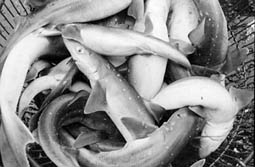 |
| Photo courtesy of Northeast Fisheries Science Center |
Spiny dogfish are small sharks between three to four feet [one to 1.2 meters] long. This species is the most prolific shark found in the Gulf and is harmless to humans. Spiny dogfish are commonly referred to as "sand or cape sharks." The spines found along the forward edges of each dorsal fin help to identify them. These spines are extremely sharp and are used by the shark to inflict injury if bothered. This species is usually found in large schools separated by age, sex and size. Spiny dogfish move from deeper offshore wintering grounds to inshore waters usually showing up in May and staying through November. They are found around shallow banks and ledges. Spiny dogfish are opportunistic feeders that prefer to eat small fish.
Blue shark
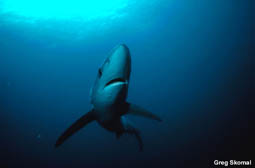 |
| Photo: Greg Skomal, MA Division of Marine Fisheries |
Blue sharks are very common in offshore waters during summer months. They grow to 12 feet [3.6 meters] and can weigh more than 400 pounds. They feed on small schooling fishes such as herring. These sharks are not considered dangerous to humans, but should be respected. Recreational fishermen catch thousands of blue sharks each year primarily during shark fishing tournaments. Most are released. Preliminary studies have shown that this species recovers quickly after being caught and released and usually resumes normal vertical feeding patterns within two hours. Blue sharks have a long slender body and long pointed snout with long pectoral fins, which aids in their field identification.
Shortfin mako
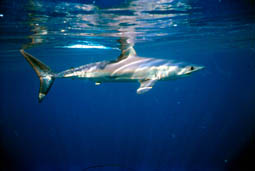 |
| Photo: Greg Skomal, MA Division of Marine Fisheries |
Shortfin mako sharks are occasional visitors to the Gulf. This large pelagic shark begins showing up by July of each year. They grow to lengths of 13 feet [four meters] and weight 1,200 pounds. Makos have a heavier body than the blue shark and a more blunt nose and much shorter pectoral fins. This shark is designed for speed and can go faster than 30 mph in pursuit of food. Its teeth are dagger-like for grabbing their preferred prey–bluefish.
Great white
City of Dover, New Hampshire
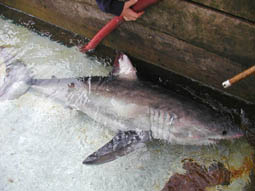 |
| Photo: Greg Skomal, MA Division of Marine Fisheries |
The most recognizable shark and the most feared, the great white shark, is considered a rare visitor to the Gulf of Maine [an 18-foot great white was entangled in a spiny dogfish gillnet and landed in 1996, and a three-foot juvenile was caught and released two years ago, both off Massachusetts]. Its appearance is considered sporadic at best, depending upon food sources and environmental conditions. Smaller great white sharks of less than 6.5 feet [two meters]
seldom move north of Cape Cod.
Sand tiger shark
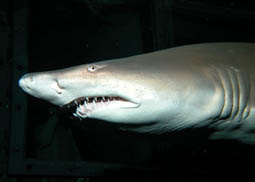 |
Photo: Bob Michelson
(taken at the New England Aquarium) |
Two large dorsal fins, protruding teeth and large size [seven feet/two meters] distinguish the sand tiger shark from other inshore sharks. Deep bodied and sluggish, it swallows air at the surface to maintain buoyancy. This allows it to swim much slower than other sharks, which maintain lift with speed. There have only been three sightings of this shark in Canadian waters.
Basking shark
St. Andrews, New Brunswick
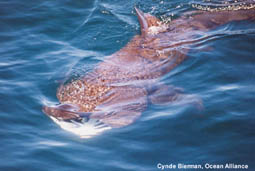 |
| Photo: Cynde Bierman, Ocean Alliance |
The second largest shark in the world with lengths of over 40 feet [12 meters], the basking shark, is the largest shark that visits the Gulf of Maine region. They are here from May through October and can be observed both inshore and offshore, usually congregated with several other basking sharks while feeding. This shark is completely harmless because it does not have any teeth and is a filter feeder, which preys primarily on copepods–tiny animal plankton. Most observations are made while on whale watch trips. The shark has a large evenly shaped triangular dorsal fin, which is normally observed breaking the surface as it feeds. Its mottled gray and black color, along with its tremendous size, make identification of this species relatively easy
Porbeagle
Halifax, Nova Scotia
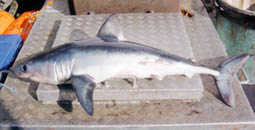 |
| Photo: Dr. Steven Campana, Canadian Shark Research Laboratory |
Here is another occasional visitor. Unlike the other warm water species, this creature is a cold-water shark, moving south from waters off Nova Scotia into the Gulf of Maine as far south as Massachusetts during winter months. They retreat to colder waters when all other species are active in the region. Porbeagle's are a close relative of the mako, reaching lengths of 12 feet [3.6 meters], but this species has a stouter body and tiny cusps at the base of its teeth. They feed on small schooling fishes, cod-like fishes and squid.
Thresher
Amherst, Nova Scotia
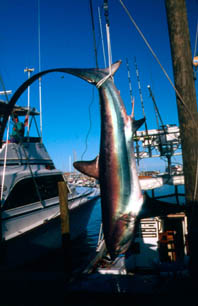 |
| Photo: Greg Skomal, MA Division of Marine Fisheries |
Thresher sharks are occasionally to rarely seen. Little is known about their behavior. They grow to lengths of 18 feet [5.4 meters]. Slow growers, they reach maturity at about six to eight years of age. Their whip-like tail takes up half the length of their body. The thresher uses its tail to herd and stun its prey.
|

![]()







